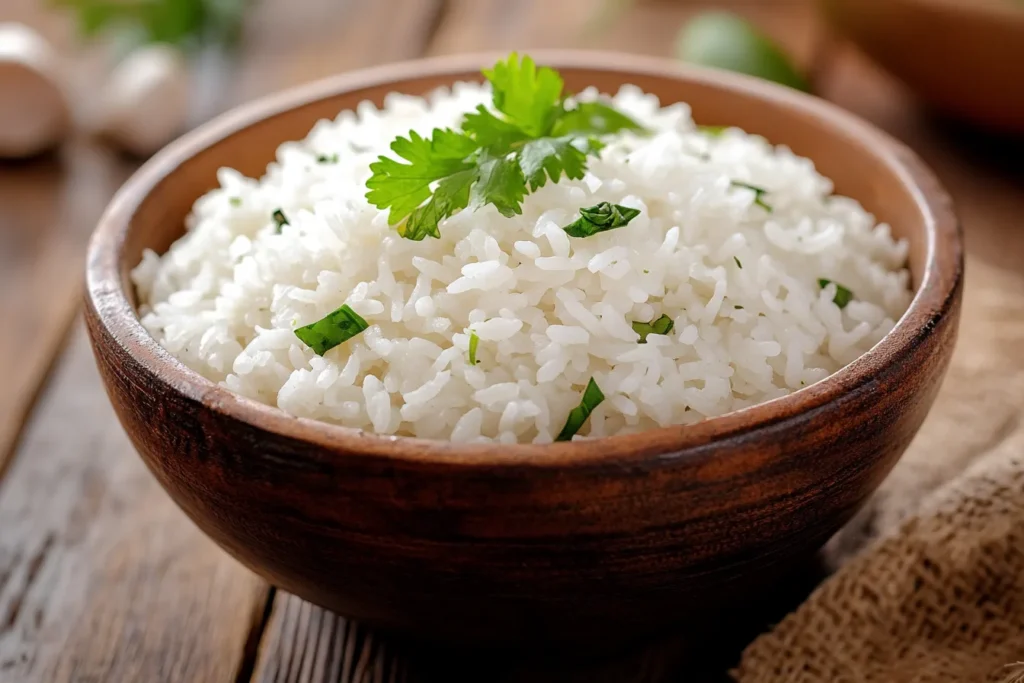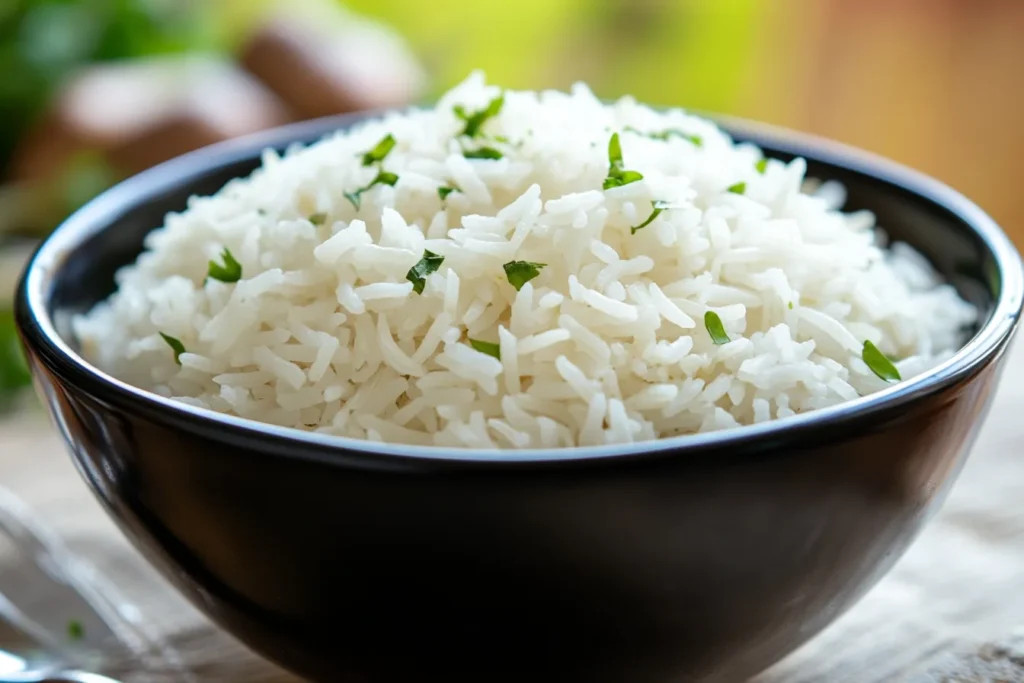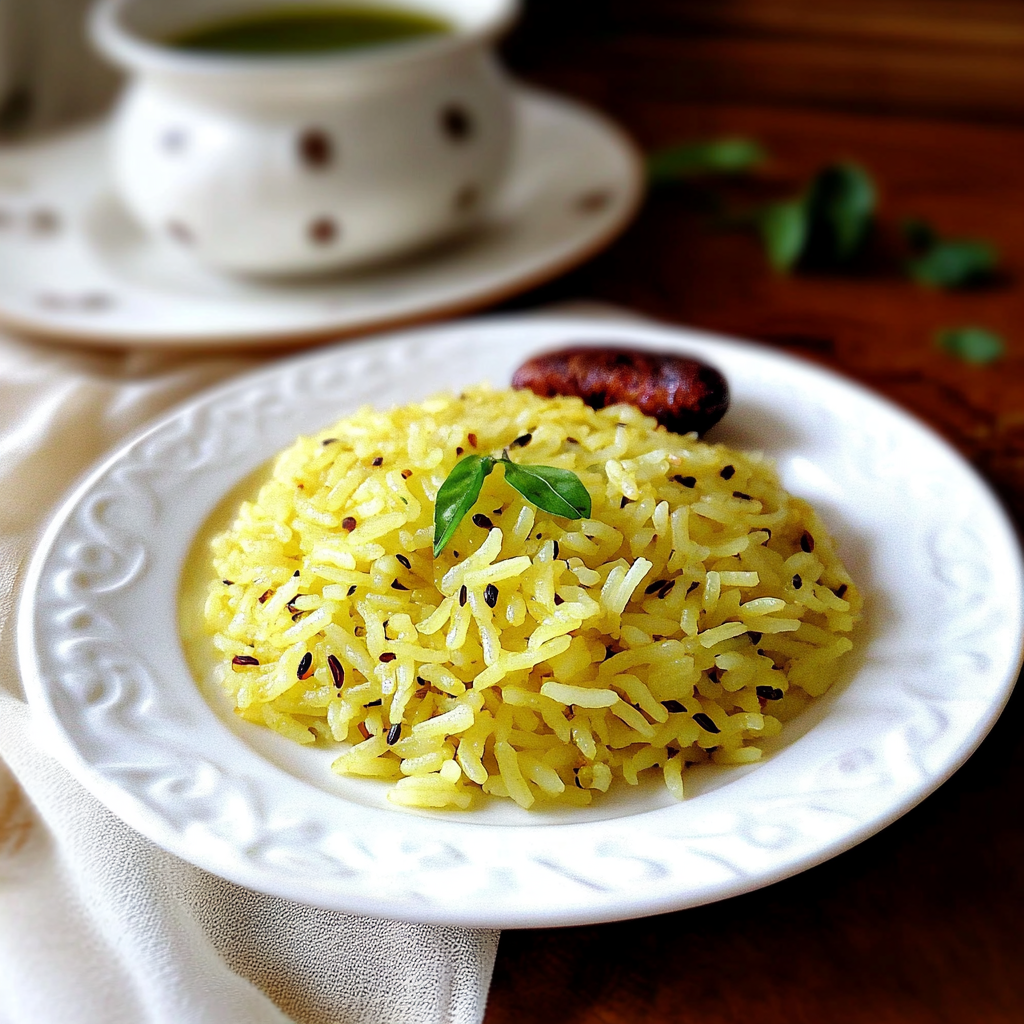Coriander rice is a delightful dish cherished for its vibrant flavors and aromatic appeal. It is a simple yet versatile recipe made primarily with rice and coriander leaves, making it a favorite across many cuisines. In this article, we’ll explore everything about coriander rice, from its key ingredients to preparation techniques and variations.
Part 1: Introduction to Coriander Rice
Definition of Coriander Rice
Coriander rice is a rice dish infused with the herbaceous flavors of coriander leaves, also known as cilantro in some regions. This dish is popular for its light, refreshing taste and pairs beautifully with both vegetarian and non-vegetarian side dishes.
The core of coriander rice lies in its simplicity: rice, coriander paste, and a handful of spices come together to create a harmonious blend of flavors. Whether served as a standalone meal or a side dish, it has earned its place in households and restaurant menus alike.
Origin and Cultural Significance
Coriander rice has its roots in South Asian and Middle Eastern cuisines. In India, it is commonly prepared during festive occasions, celebrations, and family meals. The dish is also embraced in Southeast Asian countries, where coriander is a staple ingredient in many recipes.
Coriander leaves, with their bright green color and earthy aroma, symbolize freshness and purity. This makes coriander rice a refreshing choice for both lunch and dinner tables.
Why Coriander Is the Star Ingredient
Coriander isn’t just a garnish—it’s the heart and soul of this recipe. Known for its bright citrusy notes and subtle sweetness, coriander elevates the flavor profile of rice like no other herb can. Beyond taste, coriander also brings health benefits, being rich in vitamins, minerals, and antioxidants.

Key Ingredients in Coriander Rice
1. Coriander Leaves: Fresh and Fragrant
The key ingredient, coriander leaves, must be fresh to achieve the dish’s signature aroma and flavor. These leaves are blended into a paste that serves as the base for the rice.
- Tip: Opt for bright green, crisp coriander leaves for the best results.
2. Rice Varieties Typically Used
For coriander rice, long-grain varieties like basmati or jasmine rice are preferred because they remain fluffy and non-sticky after cooking. These rice types absorb the coriander paste well, ensuring an even distribution of flavors.
- Alternative: Short-grain rice or parboiled rice can also be used, depending on texture preferences.
3. Oil or Ghee for Cooking
The choice of cooking fat significantly affects the flavor. While oil provides a neutral base, ghee adds richness and depth to the dish.
- Healthier Option: Use coconut oil for a nutty flavor or olive oil for a lighter version.
4. Aromatics: Garlic, Ginger, and Onion
These ingredients form the flavor foundation. Garlic and ginger bring warmth, while onions add a slight sweetness that balances the boldness of coriander.
5. Spices for Depth: Cumin, Cloves, and Cinnamon
Spices like cumin seeds, cloves, and a small stick of cinnamon are often added during tempering. These spices enhance the earthy, warming qualities of coriander rice.
Optional Ingredients
1. Green Chilies for Heat
For those who enjoy a kick of spice, finely chopped green chilies can be added. Adjust the quantity based on your heat tolerance.
2. Lemon Juice for Tanginess
A squeeze of fresh lemon juice at the end brightens the flavors and adds a tangy contrast to the herbal notes of coriander.
3. Nuts and Seeds for Crunch
Roasted cashews, almonds, or sesame seeds can be sprinkled on top to introduce a crunchy texture and enhance the dish’s visual appeal.
Preparing Coriander Paste
Grinding Coriander with Spices
To make the coriander paste, blend fresh coriander leaves with garlic, ginger, green chilies, and a small amount of water. Add a pinch of salt to intensify the flavors.
Adding Water or Yogurt for Consistency
To achieve the right texture, add a little water or yogurt to the paste. Yogurt gives a creamy consistency, while water keeps it light.
- Tip: Avoid adding too much liquid to prevent the paste from becoming runny.
Storing Coriander Paste for Later Use
Store any leftover coriander paste in an airtight container in the refrigerator. It can last up to a week or be frozen for longer shelf life.
Choosing the Right Rice
Long-Grain vs. Short-Grain Rice
Long-grain rice, such as basmati, is ideal for coriander rice because of its light and fluffy texture. Short-grain rice, while stickier, can work for variations of the dish, particularly in Asian-inspired recipes.
Parboiled vs. Basmati: Which Works Best?
Basmati rice is the top choice for its aromatic properties, but parboiled rice can be used if you prefer a firmer texture that holds up well during mixing.
What Is Coriander Rice Made Of? (Part 2)
In this section, we’ll delve deeper into the preparation process for coriander rice, covering a step-by-step guide, different cooking methods, and creative variations that make this dish incredibly versatile.
Step-by-Step Guide to Making Coriander Rice
1. Washing and Cooking the Rice
- Start by washing the rice thoroughly under running water to remove excess starch. This ensures the rice remains fluffy after cooking.
- Depending on the recipe, you can either cook the rice in advance or prepare it simultaneously with the masala (spice mix).
- Use the absorption method for perfectly cooked rice: for every cup of rice, use 1.5 to 2 cups of water.
- Pro Tip: Adding a few drops of oil while cooking rice prevents the grains from sticking together.
2. Preparing the Coriander Masala
- Heat oil or ghee in a pan and temper it with whole spices like cumin seeds and a cinnamon stick.
- Sauté chopped onions until golden, then add minced garlic, ginger, and green chilies.
- Stir in the freshly prepared coriander paste, cooking it until the raw aroma fades. This step ensures the coriander flavor deepens without overpowering the dish.
3. Combining Rice and Masala for Uniform Flavor
- Gently mix the cooked rice into the coriander masala. Use a spatula to fold the rice evenly without breaking the grains.
- Taste the dish and adjust the seasoning with salt and lemon juice.

Cooking Methods
1. Stove-Top Method
The most common way to cook coriander rice is on the stovetop. This method allows you to sauté the spices and masala directly in a pan and mix them with cooked rice.
- Ideal for: Beginners and quick preparation.
- Drawback: Requires close monitoring to avoid burning the spices.
2. Pressure Cooker for Quick Cooking
For faster results, you can use a pressure cooker to prepare coriander rice. Add all the ingredients (coriander paste, spices, and uncooked rice) into the cooker, ensuring the water-to-rice ratio is accurate.
- Ideal for: Busy weeknights or meal prepping.
- Drawback: Less control over the rice texture.
3. One-Pot vs. Separate Preparation Techniques
- One-Pot Method: Cook the rice directly in the same pan as the masala, allowing the flavors to seep deeply into the rice.
- Separate Preparation: Cook the rice and masala separately, then combine them. This method is preferred for achieving distinct flavors.
Enhancing the Flavor Profile
1. Tempering with Spices in Oil or Ghee
Aromatic tempering can elevate the dish significantly. Heat oil or ghee, add mustard seeds, curry leaves, and dry red chilies, and pour this tempering over the rice just before serving.
2. Balancing Flavors with Acidity and Heat
To achieve a perfect balance:
- Use lemon juice for acidity.
- Add yogurt for a mild tangy flavor.
- Adjust the spice level with green chilies or red chili powder.
Alternative Ingredients and Substitutions
1. Making it Vegan with Plant-Based Oils
Coriander rice can easily be made vegan by using coconut oil, avocado oil, or any other plant-based oil instead of ghee.
2. Gluten-Free Additions
The dish is naturally gluten-free, but always ensure that store-bought spices or additives are certified gluten-free to avoid contamination.
3. Substituting Coriander with Parsley for a Twist
For a unique flavor, parsley can be used as a substitute for coriander. The result is a more herbaceous and slightly less citrusy rice dish.
Variations of Coriander Rice
1. South Indian Style with Coconut
Adding grated coconut to the coriander paste lends a creamy texture and nutty flavor. Pair it with a traditional rasam or sambar for an authentic experience.
2. North Indian Style with Richer Spices
In North India, coriander rice is often enhanced with garam masala, bay leaves, and saffron strands, making it aromatic and festive. Serve it with rich curries like paneer butter masala.
3. International Fusion with Coriander Rice
Experiment with global flavors by adding soy sauce, sesame oil, or stir-fried vegetables to create an Asian-inspired coriander rice dish. It’s a great way to enjoy the dish with a modern twist.
What Is Coriander Rice Made Of? (Part 3)
In this final part, we’ll focus on the nutritional benefits of coriander rice, serving suggestions, storage tips, and creative ways to customize the dish to suit your taste and dietary preferences. Let’s wrap up this journey into coriander rice with some exciting details.
Nutritional Profile of Coriander Rice
1. Nutritional Value of Coriander
Coriander leaves are not just about flavor; they’re a powerhouse of nutrients. Packed with vitamins A, C, and K, coriander is known for its anti-inflammatory and antioxidant properties. These nutrients contribute to better skin health, immunity, and bone strength.
- Vitamin A: Supports vision and skin health.
- Vitamin C: Boosts the immune system.
- Vitamin K: Aids in blood clotting and bone metabolism.
2. Caloric Content of Ingredients
The calorie count of coriander rice depends on the ingredients and cooking method. Here’s an approximate breakdown:
- Rice: 200 calories per cup of cooked rice.
- Coriander Paste: Negligible calories, primarily from vitamins and minerals.
- Oil or Ghee: Adds around 40–50 calories per tablespoon.
- Aromatics and Spices: Minimal calorie contribution.
On average, a serving of coriander rice provides around 250–300 calories, making it a light yet satisfying dish.
3. Benefits of Using Minimal Oil
Using minimal oil or opting for healthy oils like olive or coconut oil reduces the dish’s overall fat content. This makes Cilantro Rice a heart-healthy option while still being rich in flavor.
Serving Suggestions
1. Pairing with Yogurt-Based Raita
Coriander rice pairs exceptionally well with cooling raitas such as cucumber or mint raita. The creamy texture of yogurt complements the herbaceous rice.
2. Side Dishes That Complement Coriander Rice
To create a complete meal, serve coriander rice with:
- Vegetable curries like mixed vegetable korma or aloo masala.
- Protein-rich dishes like paneer tikka or grilled chicken.
- Lentil-based sides like dal tadka or sambhar.
These combinations enhance the meal’s flavor and nutritional profile.
Storage and Reuse
1. Storing Leftovers Safely
To store Cilantro Rice:
- Transfer it to an airtight container once it has cooled to room temperature.
- Refrigerate for up to 3 days or freeze for up to 2 months.
2. Transforming Leftovers into New Dishes
Leftover Cilantro Rice can be creatively repurposed:
- Fried Rice: Add vegetables, soy sauce, and scrambled eggs for a quick fried rice dish.
- Rice Patties: Mix the rice with breadcrumbs and spices, shape into patties, and pan-fry them.
- Rice-Stuffed Vegetables: Use the rice as a filling for bell peppers, zucchini, or tomatoes.
Creative Twists on Coriander Rice
1. Adding Proteins like Paneer or Chicken
Incorporating proteins can make Cilantro Rice a complete meal:
- Paneer cubes can be sautéed and mixed into the rice for a vegetarian option.
- Shredded or grilled chicken pairs beautifully with the flavors of coriander.
2. Making a Coriander Pilaf with Exotic Spices
To elevate Cilantro Rice to a festive dish, turn it into a pilaf:
- Add saffron, raisins, and toasted nuts.
- Use whole spices like cardamom and bay leaves for an aromatic touch.
Conclusion
Coriander rice is a versatile dish that combines the vibrant flavors of fresh herbs with the comfort of rice. Its simplicity, adaptability, and nutritional benefits make it a favorite among home cooks and chefs alike. Whether you’re hosting a dinner party or preparing a quick weeknight meal, coriander rice is always a reliable choice.
More FAQs
- Can I Use Dried Coriander Instead of Fresh?
- Fresh coriander is recommended for its flavor and aroma, but dried coriander leaves can be used as a last resort.
- What Are Good Substitutes for Green Chilies?
- Use red chili powder or black pepper for heat.
- How Do I Prevent Rice from Becoming Sticky?
- Wash the rice thoroughly before cooking and use the right water-to-rice ratio.
- Can I Make Coriander Rice Ahead of Time?
- Yes, prepare the coriander paste and cook the rice in advance. Combine them before serving.
- Is Coriander Rice Gluten-Free?
- Yes, it is naturally gluten-free.
- Can I Add Vegetables to Coriander Rice?
- Absolutely. Peas, carrots, and beans work well.
- What’s the Best Way to Reheat Coriander Rice?
- Reheat on the stove with a splash of water or in the microwave.
- Can I Skip the Garlic and Onion?
- Yes, for a milder flavor or dietary restrictions, you can omit them.
- What’s the Best Rice for This Recipe?
- Basmati rice is ideal, but jasmine or parboiled rice can also be used.
- Can I Use Coriander Stems in the Paste?
- Yes, coriander stems are flavorful and blend well into the paste.
Related Article : Coriander Rice Recipe

